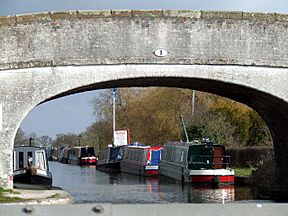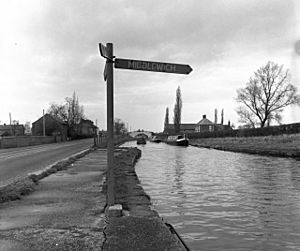Barbridge Junction facts for kids
Quick facts for kids Barbridge Junction |
|
|---|---|

Narrowboats at Barbridge Junction
|
|
| Specifications | |
| Status | Open |
| Navigation authority | British Waterways |
| History | |
| Date completed | 1833 |
Barbridge Junction is a special place on the Shropshire Union Canal in Cheshire, England. It's where two parts of the canal meet! One part is the main Shropshire Union Canal, and the other is called the Middlewich Branch. Think of it like a crossroads for boats, allowing them to travel in different directions.
Contents
How Barbridge Junction Came to Be
The Idea for the Chester Canal
The idea for the Chester Canal started way back in 1771. People wanted to connect the new Trent and Mersey Canal with the River Dee. This connection would help the city of Chester stay an important port.
In 1772, a special law, called an Act of Parliament, was passed. This law allowed them to build a narrow canal from Chester to Middlewich. It also included a smaller branch to Nantwich.
Early Challenges and Changes
There were some problems at first. Other canal owners, like the Duke of Bridgewater, didn't want the new canal to connect directly to theirs. So, the Chester Canal had to stop about 100 yards (91 m) away from the Trent and Mersey Canal.
The builders decided to make a wide canal, big enough for boats up to 80 feet (24 m) long and 14.75 feet (4.5 m) wide. This canal went from Chester to Nantwich. But by 1779, they ran out of money before reaching Middlewich. The canal wasn't very successful at first.
A New Beginning for the Canal
Things started to look up when the Ellesmere Canal began to be built. The Chester Canal became part of a bigger canal network. This meant more boats and more trade! In 1813, the two companies joined together. They became known as the Ellesmere and Chester Canal.
Building the Middlewich Branch
A new canal, the Birmingham and Liverpool Junction Canal, was planned. This new canal would connect Nantwich to other important canals. This made the branch to Middlewich even more important. It would help boats from the new canal reach Manchester.
After 1824, the canal company tried again to connect Nantwich and Middlewich. This time, the Bridgewater Trustees agreed. But the Trent and Mersey Canal only agreed after the new Birmingham and Liverpool Junction Canal was officially approved.
The Middlewich Branch Opens
In 1826, the Birmingham and Liverpool Junction Canal got its official approval. Then, in 1827, the Ellesmere and Chester Canal got their own Act of Parliament. This allowed them to build the Middlewich Branch.
The Trent and Mersey Canal built a short section called the Wardle Canal. It had one lock and charged high fees for boats using it. Despite this, the work continued. The Middlewich Branch finally opened on September 1, 1833. It cost a lot of money, about £129,000!
Joining the Shropshire Union Canal
At Barbridge Junction, new warehouses and docks were built. These were used to transfer goods between boats. The Middlewich Branch didn't get very busy until the Birmingham and Liverpool Junction Canal opened in 1835.
Just ten years later, in 1845, the two main canal companies joined forces. In 1846, their combined canal system became known as the Shropshire Union Canal network.
Where Barbridge Junction Is Located
From Barbridge Junction, the original Chester Canal goes north-west. It stays flat for about 2.8 miles (4.5 km). Then, boats reach the first of two locks called Bunbury Locks. These locks help boats go down towards Chester.
Going the other way, the canal is flat for about 5.5 miles (8.9 km). After that, boats reach the two Hack Green Locks.
Along the Middlewich Branch, which goes north-east, the first lock is Cholmondeston Lock. It's about 1.4 miles (2.3 km) from the junction.
Just 2 miles (3.2 km) south of Barbridge Junction on the main canal is Hurleston Junction. This is another important spot where a different branch of the Shropshire Union network, now called the Llangollen Canal, turns off towards Llangollen and the Montgomery Canal.


